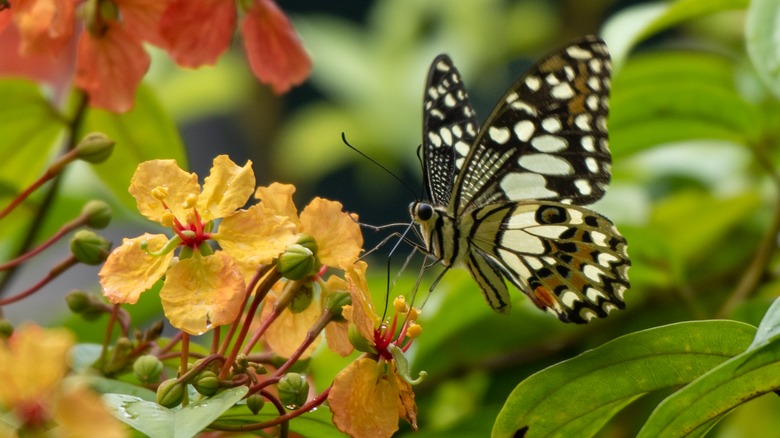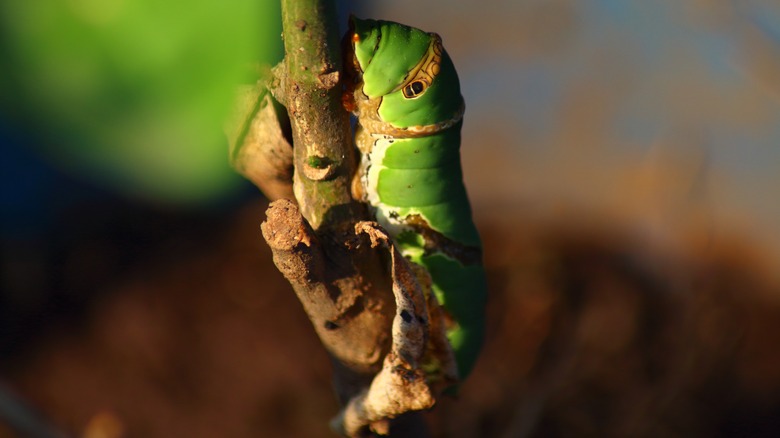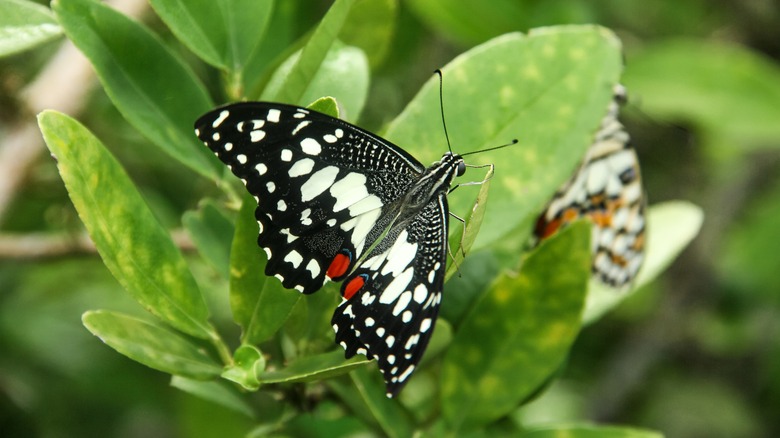Why Seeing A Lime Swallowtail Butterfly Is A Bad Sign For Your Citrus Trees
Usually, there's nothing more exciting for a gardener than seeing a beautiful butterfly flutter around their yard. Although the goal is typically to attract pollinators to your garden, seeing a lime swallowtail land on one of your flowers could be a red flag. Already a nuisance to our neighbors in Jamaica, this invasive species, scientifically known as Papilio demoleus, can cause some serious damage to citrus trees in North America. Although its black and yellow wings may be eye-catching, the larvae are the real threat, as they are capable of defoliating citrus trees. That's especially bad news for Florida, the state known for its orange trees.
Native to Asia, this subspecies of the lime swallowtail has made its way all over the world and seems to be able to adapt to new environments with ease. Experts, like Trevor Smith from the Florida Department of Agriculture, believe Hurricane Ian may have helped this pest make its voyage into the U.S. So far, there have only been sightings in Key West, but that doesn't mean they won't continue to spread to other areas. If you spot any lime swallowtail butterflies in your yard, it could be a sign of trouble for your citrus trees. Let's get into why this pollinator is so problematic and what to do if you spot it.
Why spotting a lime swallowtail butterfly could spell trouble for your trees
Although the butterflies are harmless, their presence may indicate hungry caterpillars nearby. Once the butterfly lays eggs on your beloved citrus tree leaves, the larvae hatch and immediately feed on the plant's foliage. To spot butterfly eggs in your garden, use a magnifying glass and look for tiny 1mm white to yellow dots on the edges or undersides of your leaves. The eggs develop into tiny caterpillars that are black with white bands, resembling bird droppings. They then transition to a pale green with bright patterns and to a final solid lime green stage. Sightings are more common in late spring to early summer, though depending on the climate, they can produce multiple generations throughout the year.
Any sightings could spell serious trouble if you have trees in the Rutaceae family, as they feed on nearly any species in this group. Some trees that satiate the lime swallowtail caterpillar's appetite include citrus plants like bitter orange (Citrus x aurantium) and Key lime (Citrus x aurantiifolia). They've also been known to snack on other family members, like the curry-leaf tree (Murraya koenigii). Lime swallowtail larvae are voracious eaters, and they spend all of their time munching on one tree, which can quickly lead to extensive defoliation. This doesn't just make it harder for the trees to obtain nutrients from the sun; it leaves the fruit exposed to the harsh rays, reducing the quality of the fruit.
What to do if you see lime swallowtail butterflies in your garden
If you see any butterflies adorned with a black-and-white spotted pattern lurking near your citrus trees, you may want to take a closer look. Once you confirm they've landed in your backyard, inspect the leaves of any plants you have in the Rutaceae family and remove any eggs or larvae by hand. Although sometimes time-consuming, hand-picking should be enough in most cases. However, if your trees have already undergone some damage, you may need to turn to a pesticide like Bacillus thuringiensis to eliminate a large quantity. For a chemical-free approach, you can give neem oil, an extract from the neem tree, a try. This natural ingredient kills small insects, like caterpillars, by suffocating them.
Even if you haven't been bothered by lime swallowtail butterflies, it's never a bad idea to take preventative measures. Continue your regular inspections, especially in late spring and early summer when lime swallowtail activity peaks. Grow tansies under your orange trees (Tanacetum vulgare) to attract a natural predator: the parasitic wasp. Although the name may sound scary, they aren't dangerous to humans; instead, they target caterpillars and other pests that can harm your plants. However, the best thing you can do to maintain the overall health of your trees is proper watering, fertilization, and pruning to make your citrus trees more resilient to pest damage.


